Sandstone Sagas
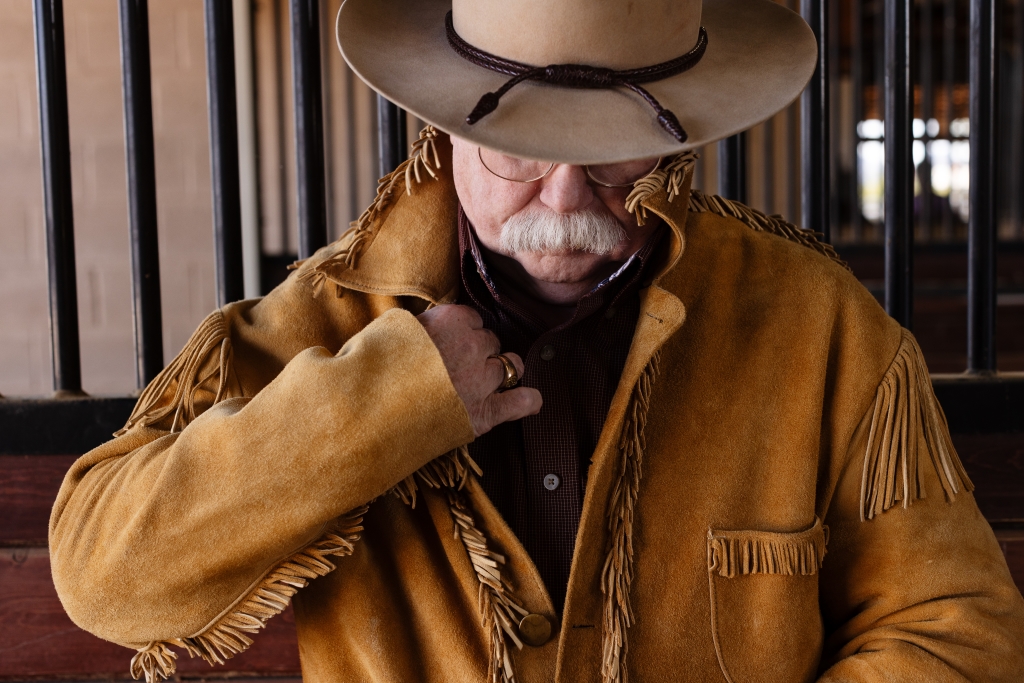
Writer Joseph J. Airdo // Photography by Loralei Lazurek



As the sun dips below the horizon, casting a warm glow across Monument Valley’s towering sandstone buttes, it’s easy to see why this breathtaking landscape has captivated filmmakers, artists and storytellers for generations. The majestic rock formations seem to defy gravity, their silhouettes standing as eternal sentinels guarding an ancient land steeped in mystery and rich cultural traditions.
For the Navajo people, Monument Valley — known as Tsé Bii’ Ndzisgaii or “Valley of the Rocks” — is a sacred place where their ancestors first emerged into this world. Their spiritual connection to the land runs deeper than the roots of the juniper and pinyon pines that cling to the arid soil.
It’s no wonder, then, that legendary filmmaker John Ford found endless inspiration within these hallowed grounds. In his quest to capture the grandeur and essence of the American West on celluloid, Ford turned to Monument Valley time and again, cementing its place as an iconic backdrop and transforming it into a silver screen symbol of the frontier’s rugged beauty and uncompromising spirit.
In his new book “The Cavalry Trilogy: John Ford, John Wayne and the Making of Three Classic Westerns,” author Michael F. Blake offers an unprecedented behind-the-scenes look at how the director’s cinematic mastery brought this extraordinary landscape to life. A two-time Emmy-winning makeup artist with more than 60 years in the film industry, Blake combines his insider’s perspective with meticulous research, guiding readers through the creation of three of Ford’s most revered Westerns — “Fort Apache,” “She Wore a Yellow Ribbon” and “Rio Grande.”
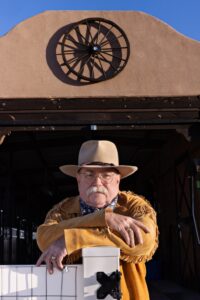


Monumental Memories
For Blake, the journey toward this book began in his childhood when his father, a character actor who worked with Ford in the 1949 stage adaptation of “What Price Glory” and the 1962 television anthology “Flashing Spikes,” first introduced him to the director’s artistry.
“My dad brought me to an afternoon roadshow screening of ‘Cheyenne Autumn’ at the Pantages Theatre in Hollywood,” Blake recalls. “I was a cowboy-crazy kid, so I loved the cavalry and the Indians. But the landscape I saw on the big screen was like nothing I’d ever seen before.”
That landscape was, of course, Monument Valley, where Ford shot eight of his most famous films.
“My dad would sit down with me and explain Ford’s directorial techniques, pointing out how he put together a scene and how the actors moved effortlessly,” Blake continues. “He’d also point out Ford’s humor. My dad planted the seeds for my love of John Ford’s films, and I never tire of watching them.
“I believe he is the greatest director in American cinema. His four directing Oscars support this claim, a record no one has surpassed.”
This early exposure sparked a lifelong fascination that only deepened as Blake embarked on his own Hollywood career. His father’s stories offered glimpses into Ford’s quirks and personality — a famously brusque exterior that belied a profound respect for the Indigenous cultures he depicted on screen.
“Ford loved the Navajos,” Blake says. “He immediately took a liking to them. Whenever he could find a story that would take him to Monument Valley, he went there. And he always made sure that they were well-paid and fed. His company would come in, and even if they were only there for about two weeks, they would put a good $100,000 into the community.”
“Ford told a story about how, on his first day on set for one of the films at Monument Valley, the Navajo people gathered and began singing ‘Happy Days Are Here Again’ in their language. Ford took this as a great honor and a great tribute.”
This mutual respect ran both ways. When Monument Valley was struck by a devastating snowstorm shortly after filming She Wore a Yellow Ribbon, leaving the local Navajo community trapped and facing potential starvation, Ford sprang into action. Leveraging his military connections as a highly decorated naval officer, he orchestrated an emergency food airdrop — a gesture that led to his being made an honorary member of the tribe under the name “Natani Nez” or “Tall Leader.”
Such stories, coupled with Ford’s insistence on hiring Navajo actors and extras, reveal a filmmaker deeply invested in authenticity and preserving cultural traditions.
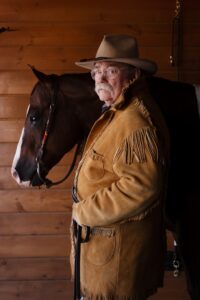


Filming the Frontier
Indeed, Ford’s connection to Monument Valley and the Navajo Nation was far more than a director’s fleeting fancy with an exotic location. He was drawn to the region’s raw, untamed beauty and the resilient spirit of its people — qualities he sought to immortalize in his films.
This reverence for the American West’s visual splendor is evident in some of the trilogy’s most iconic shots, which seem torn from the canvases of Frederic Remington and Charles Russell — two of the most influential artists in shaping the imagery of the American West during the late 19th and early 20th centuries.
For instance, in “She Wore a Yellow Ribbon,” a thunderstorm sequence captures the cavalry riding through Monument Valley, the chiseled rock formations looming in the background like ancient gods bearing witness to the scene’s drama and violence.
“It’s like Charles Russell’s paintings come to life,” Blake marvels, adding that Russell’s color palette can also be seen quite clearly in the Technicolor version of the movie. “Ford was a master at capturing beauty and emotion with his camera.”
To emphasize this, Blake dissects the staging of a heartrending moment in Fort Apache when Cochise casts dirt into the wind, resigning himself and his people to war without uttering a word.
“It’s a powerful scene, demonstrating Ford’s ability to convey emotions without words,” Blake explains. “Any dialogue would have diminished its impact.”
Ford’s masterful use of Monument Valley’s stark beauty to evoke the spirit of the American West was not just a matter of artistic vision but also a testament to his technical skill and work ethic as a filmmaker. Moreover, Blake’s decades of Hollywood experience on major film sets like Back to the Future Part III, which included second unit filming in Monument Valley, lend his book unparalleled authenticity and an invaluable insider’s perspective.
“John Ford shot ‘Fort Apache’ in 45 days, 15 days under the schedule,” the author says. “He shot ‘Rio Grande’ in 32 days and ‘She Wore a Yellow Ribbon’ in just 31. That’s unheard of today. It takes a good two to three months for a movie to be made. When I worked on ‘Spider-Man 3,’ I was on and off it for a year. So it’s amazing what Ford did and how quickly he did it, not to mention how wonderfully he did it.”
From the grueling shooting schedules to the logistical challenges of transporting an entire crew and cast to the remote valley, Blake regales readers with a trove of entertaining anecdotes and behind-the-scenes glimpses, transporting them beyond the silver screen to experience the blood, sweat and tears that went into immortalizing this most hallowed of American landscapes.
“I hope that through my book, readers will understand what really goes into making a movie,” Blake says. “Filming a movie on location, especially back then, was extremely hard. It was fun, but it was still very hard work. And I want people to understand that because as we get further and further away, the past becomes very dim. I am trying to bring that past to people. If nothing else, you’ll gain an appreciation for how movies are made and for the people who made them — especially John Ford.”
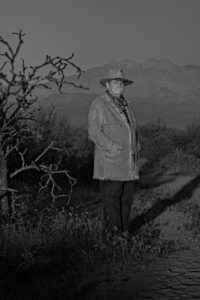


Landmarks and Legacy
As Blake’s richly detailed and lovingly crafted narrative makes clear, Ford’s Cavalry Trilogy was far more than mere entertainment — it was a reverent ode to the American West, a cinematic poem that captured the essence of its windswept mesas and canyons in all their rugged glory.
More importantly, these films paid tribute to the Navajo people and their spiritual connection to an extraordinary land — a legacy that continues to reverberate through Monument Valley’s sun-baked rocks and endless, azure skies.
“If any person other than a Navajo native should be buried there, it’s John Ford,” Blake declares. “If you ask people, especially in Europe, about the American West, they’re going to point to John Ford’s movies. And John Ford movies are Monument Valley.”
After all, the director does have a landmark in Monument Valley named after him.
“John Ford Point is my happy place,” Blake notes. “I could sit there all day in a chair and just watch the world go by.”
As visitors flock to this iconic desert valley this summer, marveling at its breathtaking vistas and exploring its ancient ruins, they will experience firsthand the grandeur that so inspired Ford’s cinematic vision. Thanks to Blake’s meticulously researched love letter of a book, they can now gain a deeper appreciation for the mastery, passion and respect for culture and place that went into shaping these indelible portraits of the American West.
Whether framed by the viewfinder of a camera or the windows of a car winding along the valley floor, Monument Valley’s majesty remains as spellbinding today as it was when Ford first brought it to the world’s attention decades ago. His Cavalry Trilogy ensured that this sacred land would forever reign as the definitive cinematic image of the frontier’s beauty, harsh realities and the indomitable human spirit.
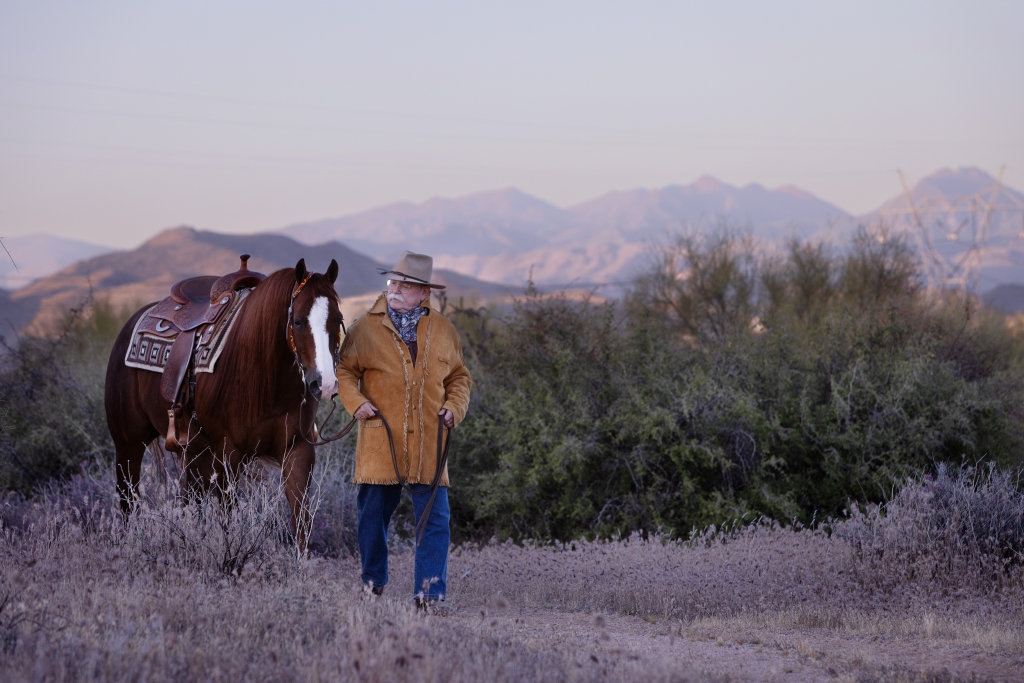


Unveiling the Secrets of a Western Legacy
Join Images Arizona’s summer book club on Friday, Sept. 27 at Desert Foothills Library in Cave Creek for an engaging exploration of Michael F. Blake’s captivating new book, “The Cavalry Trilogy: John Ford, John Wayne and the Making of Three Classic Westerns.”
This special event features an intimate discussion and live Q-and-A session with the author himself, offering invaluable insights into the making of John Ford’s legendary Cavalry Trilogy and the iconic landscape of Monument Valley that served as its backdrop. With more than 60 years of experience in the film industry, Blake provides an unparalleled behind-the-scenes look at the creation of these cinematic masterpieces.
Don’t miss this opportunity to dive deep into the untold stories of a Hollywood legend and the enduring legacy of the American West. Be sure to read the book this summer to be fully prepared for this engaging discussion!
Michael F. Blake
Friday, Sept. 27 // 1:30 p.m. // Desert Foothills Library // 38443 N. School House Road, Cave Creek // Free // 480-488-2286 // dfla.org

